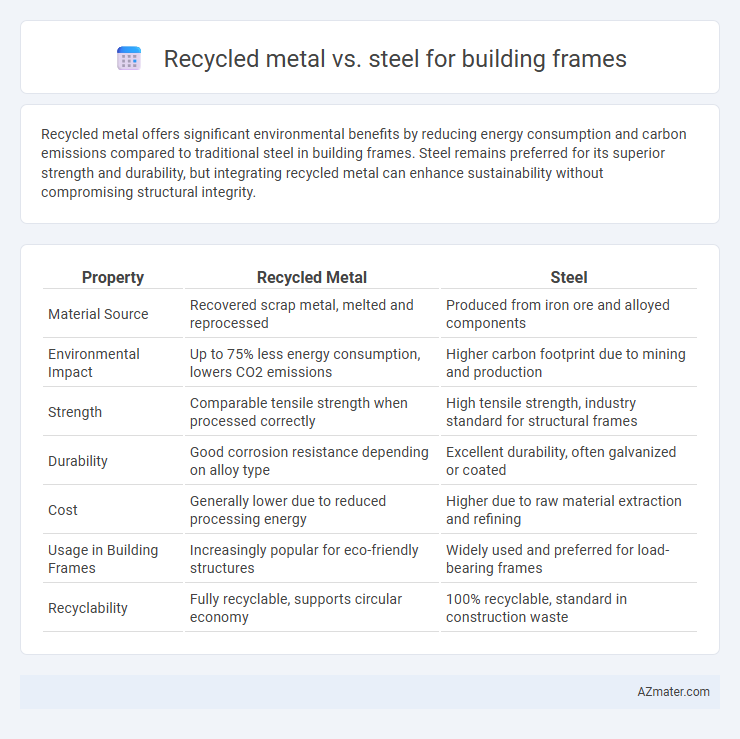Recycled metal offers significant environmental benefits by reducing energy consumption and carbon emissions compared to traditional steel in building frames. Steel remains preferred for its superior strength and durability, but integrating recycled metal can enhance sustainability without compromising structural integrity.
Table of Comparison
| Property | Recycled Metal | Steel |
|---|---|---|
| Material Source | Recovered scrap metal, melted and reprocessed | Produced from iron ore and alloyed components |
| Environmental Impact | Up to 75% less energy consumption, lowers CO2 emissions | Higher carbon footprint due to mining and production |
| Strength | Comparable tensile strength when processed correctly | High tensile strength, industry standard for structural frames |
| Durability | Good corrosion resistance depending on alloy type | Excellent durability, often galvanized or coated |
| Cost | Generally lower due to reduced processing energy | Higher due to raw material extraction and refining |
| Usage in Building Frames | Increasingly popular for eco-friendly structures | Widely used and preferred for load-bearing frames |
| Recyclability | Fully recyclable, supports circular economy | 100% recyclable, standard in construction waste |
Introduction to Building Frame Materials
Recycled metal offers a sustainable alternative to traditional steel for building frames by reducing environmental impact through minimized mining and energy consumption. Steel remains the industry standard due to its high strength-to-weight ratio, durability, and ease of fabrication, making it ideal for structural support. Incorporating recycled metal in building frames supports circular economy principles while maintaining essential mechanical properties for safety and longevity.
Overview of Recycled Metal
Recycled metal offers a sustainable alternative to traditional steel in building frames by significantly reducing environmental impact through the reuse of scrap materials. It maintains comparable strength and durability to virgin steel while lowering energy consumption and greenhouse gas emissions during production. Utilizing recycled metal supports circular economy principles and contributes to LEED certification points for green building projects.
Understanding Conventional Steel
Conventional steel for building frames is primarily produced from iron ore through a blast furnace process, offering high tensile strength and durability essential for structural integrity. Its uniform composition ensures predictable performance under stress, making it a trusted material in construction. However, the energy-intensive extraction and manufacturing process of conventional steel raises environmental concerns compared to recycled metal alternatives.
Environmental Impact Comparison
Recycled metal significantly reduces the environmental impact of building frames by lowering energy consumption and greenhouse gas emissions during production compared to virgin steel. Utilizing recycled steel reduces the need for mining raw materials, preserving natural resources and decreasing habitat disruption. Life cycle assessments show that recycled metal frames can cut carbon footprints by up to 75% relative to traditional steel frames, highlighting their sustainability advantages in construction.
Cost Analysis: Recycled Metal vs Steel
Recycled metal significantly reduces material costs in building frame construction due to lower raw material expenses and decreased energy consumption during processing compared to traditional steel. Steel prices fluctuate based on market demand and production costs, often making recycled metal a more economical choice for large-scale projects. Lifecycle cost benefits of recycled metal include savings in manufacturing, transportation, and waste management, positioning it as a cost-effective alternative to conventional steel framing.
Structural Strength and Durability
Recycled metal used in building frames retains comparable structural strength to traditional steel due to advanced processing techniques that preserve its integrity and load-bearing capacity. Steel, known for its high tensile strength and resistance to deformation, remains the industry standard for durability in construction projects requiring long-term stability. Both materials offer reliable performance, but recycled metal provides an eco-friendly alternative without significant compromises in strength or durability.
Sustainability and Green Building Certifications
Recycled metal significantly reduces environmental impact by lowering energy consumption and greenhouse gas emissions compared to producing new steel, making it a key material for sustainable building frames. Incorporating recycled metal can contribute to earning LEED and BREEAM green building certifications, as these frameworks reward the use of low-embodied energy materials and promote resource efficiency. Steel made with a high recycled content offers the same structural integrity as virgin steel while supporting circular economy principles and reducing raw material extraction.
Availability and Sourcing Challenges
Recycled metal offers a sustainable alternative for building frames but faces availability constraints due to fluctuating supply chains and inconsistent quality standards. Steel, primarily sourced from established mills, ensures greater reliability and uniformity, though it is reliant on resource-intensive mining and production processes. Sourcing recycled metal often involves navigating regional scrap market volatility, whereas steel availability benefits from a globalized manufacturing infrastructure.
Construction and Installation Differences
Recycled metal in building frames often requires specialized processing and quality checks to ensure structural integrity, whereas steel typically comes with standardized specifications ideal for rapid construction. Installation of recycled metal may involve customized fabrication to accommodate variability in material properties, leading to potentially longer assembly times compared to prefabricated steel components. Steel's uniformity supports modular construction techniques, enabling quicker on-site installation and reduced labor costs.
Future Trends in Building Frame Materials
Recycled metal in building frames is gaining traction due to its sustainability and reduced carbon footprint compared to traditional steel production. Innovations in alloy composition and recycling technologies are enhancing the strength and durability of recycled metals, making them competitive alternatives for structural applications. Future trends indicate a growing preference for eco-friendly materials, driven by stricter environmental regulations and the construction industry's commitment to net-zero emissions.

Infographic: Recycled metal vs Steel for Building frame
 azmater.com
azmater.com